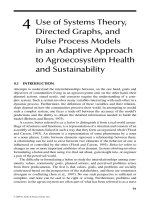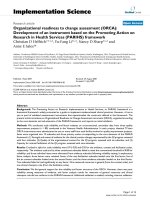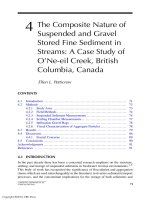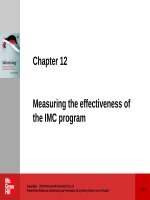Lecture Conducting and reading research in health and human performance (4/e): Chapter 4 - Ted A. Baumgartner, Larry D. Hensley
Bạn đang xem bản rút gọn của tài liệu. Xem và tải ngay bản đầy đủ của tài liệu tại đây (1.37 MB, 42 trang )
Chapter 4
Developing the Research Plan
Research Approaches
General framework for conducting research
–
–
–
–
Historical
Descriptive
Qualitative
Experimental
The general nature of the research problem will
determine which approach to use
Hypotheses
Important to most research studies
Tentative explanation of the outcome of a
research problem
In some research in the behavioral sciences,
especially descriptive studies, it may be
appropriate for the researcher to list objectives
rather than hypotheses or to exclude them all
together, unless comparisons are being made
Types of Hypotheses
Research Hypothesis - An “educated guess” or
tentative proposition regarding the possible
solution or explanation to the problem being
studied
– based on theory or previous research
Null or Statistical Hypothesis - A hypothesis of
“no difference or no relationship”
– primary use is for statistical testing
– hypothesis which says the independent variable has no effect on
the dependent variable
– does not necessarily reflect the researcher’s expectations
Hypothesis Testing
The Research Hypothesis is transformed into
a Statistical or Null Hypothesis (Ho)
– This is done so that statistical tests can be
employed that will determine whether the findings
are statistically significant or can be attributed to
chance
– The results of the statistical test will enable the
researcher to accept or reject the null hypothesis
More Hypothesis Testing
The purpose of the statistical test is to evaluate
the null hypothesis at a specified level of
probability
– For instance, testing the difference in the mean values between
2 groups at the .05 level means:
Do the values of the dependent variable differ significantly
(p<.05) so that these differences would not be attributable to
chance occurrence more than 5 times in 100?
– If the null hypothesis is accepted, then the researcher rejects the
research hypothesis and concludes there is no difference
between the groups
– If the null hypothesis is rejected, then the research hypothesis is
affirmed and the researcher concludes there is a significant
difference between the groups
Example Research Hypothesis
It is hypothesized that children taught by
teaching method A will perform better on a
reading achievement test than children taught by
method B
Direction of Expected Results
Directional Hypothesis – when the researcher has
reason to believe a particular relationship or
difference exists
– Children with a high IQ are more easily motivated than
children with a low IQ
Nondirectional Hypothesis – when the researcher
has no reason to believe a particular relationship
or difference exists in any direction
– There is a difference in the motivational level of
children with a high IQ and children with a low IQ
Example Null Hypothesis
There will be no significant difference in reading
performance between students taught by
method A and students taught by method B
or
Teaching method has no effect on the reading
performance of students
Rule of Thumb
Research which asks DIFFERENCE or
RELATIONSHIP questions should always have
hypotheses
Research which asks DESCRIPTIVE questions
(with no comparisons across groups) may not
need hypotheses
You can only reject or fail to reject the null
hypothesis
Data Collection Techniques
The nature of the study will determine what type
of data are required to answer the question and
the method of collecting these data
Multiple techniques may be used in a single
study
Three Basic Techniques
Observation - the researcher may watch the
research participants perform and record
relevant information about them
Measurement - the researcher may test the
research participants or apply a device to
measure certain qualities
Questioning - the researcher may ask the
research participants questions to obtain
information
Observation Techniques
Direct observation
Indirect observation
Participant observation
Direct Observation
Researcher directly observes research
participants
Research participants usually know they are
being observed
Researcher’s presence might change the way
the research participants act
Indirect Observation
Research participants are filmed or videotaped
Researcher views tape
Participant Observation
The observer participates in the research
setting with the research participants, often
spending considerable time in the natural setting
developing field notes
Qualitative research methodology
Measurement Techniques
This broad category of techniques involves
actively testing the research participants on the
characteristics of interest
Almost anything can be measured
Major categories of measures include
– Physical
– Cognitive
– Affective
Prevalent Types
Physical measures
– e.g., muscular strength, blood pressure, physiological responses
to exercise . . . common in HHP
Cognitive measures
– e.g., knowledge on innumerable topics
Affective measures
– e.g., opinion, attitude, interest, personality traits, motivation, selfconcept
– affective factors are often more difficult to capture quantitatively
and are typically measured through the use of pencil and paper
self-report scales
Scaling Techniques
Scaling is the process of assigning numbers to
the various levels of a particular concept that we
wish to measure. Thus, a scale provides an
indirect measure of the concept of interest
Scales can be used to obtain information on
almost any topic, object, or subject. Attitude,
opinion, behavior, performance, and perception
are frequently measured by some type of scale
Common Scales
Rating Scale
Semantic Differential Scale
Rank Order Scale
Likert Scale
Rating Scale
Individual items are judged on a single
dimension and scored on a linear scale or
continuum by selecting a numerical or verbal
point on the scale that corresponds to their
impression of the item
Numerical Rating Scale
How important to you is each of the issues listed below:
Extremely
Unimportant
1
Extremely
Important
2
3
4
5
The protection of endangered species of animals ____
The improvement of the quality of the air
____
The provision of social services to those in need ____
Verbal Rating Scale
Administrative Concept Scale
Concepts
No
Importance
Moderate
Importance
Greatest
Importance
Staff Discipline
___
___
___
Communication
___
___
___
Goal Setting
___
___
___
Public Relations
___
___
___
Computer Use
___
___
___
Semantic Differential Scale
A scaling method designed for measuring ones
“image” of a selected topic or concept. Subjects
will choose a relative position between pairs of
bipolar adjectives which describe the topic along
a single dimension
No more than about 20 items should be used.
Responses are converted to numeric values and
treated statistically
Semantic Differential Scale
Place an “x” in the space on each line below to
show your opinion of the pizza served here:
Hot
Bland
Fresh
Soggy
___ ___ ___ ___ ___ ___ ___ Cold
___ ___ ___ ___ ___ ___ ___ Spicy
___ ___ ___ ___ ___ ___ ___ Stale
___ ___ ___ ___ ___ ___ ___ Crisp









